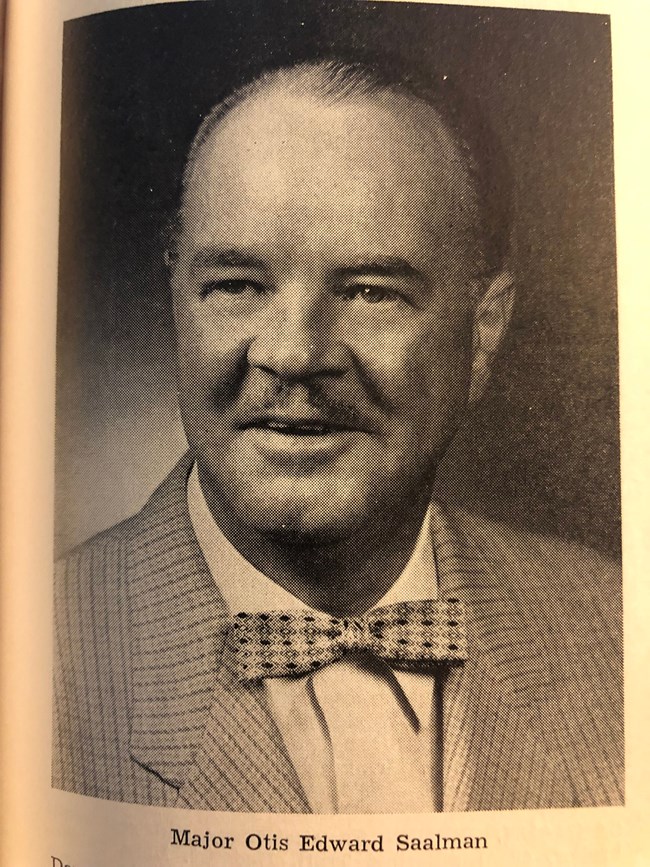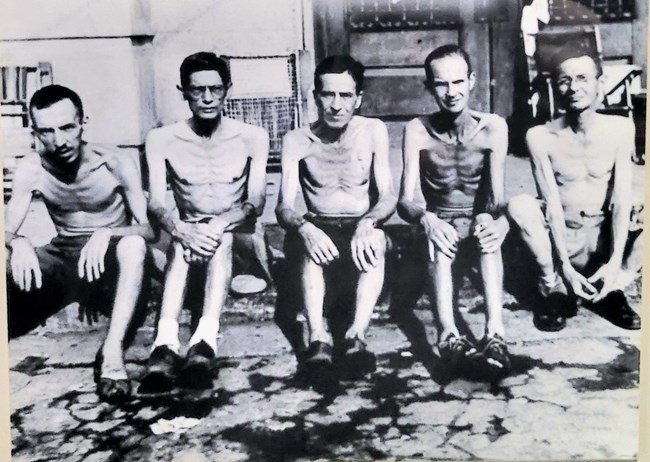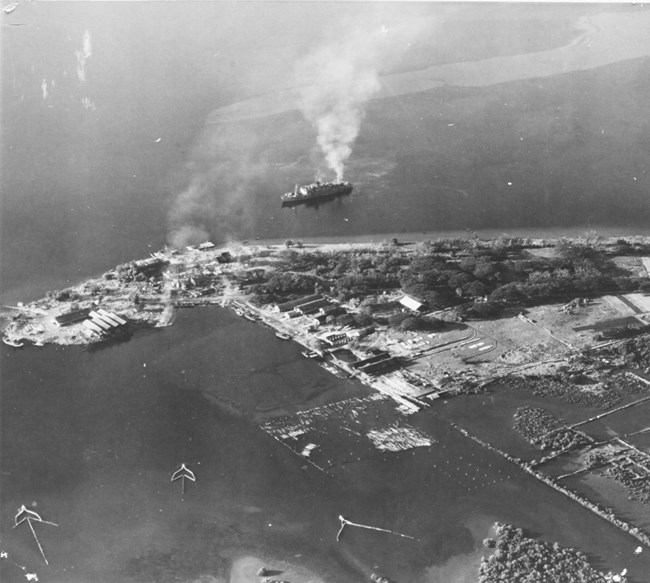
However, on May 6, 1942, General Jonathan Wainwright surrendered the men under his command, which included Otis Saalman. At the time of his capture Otis recalled that he hurled his “…gun into the China Sea, then sat down and cried. Little did we realize what the future had in store for us. We were taken to Bilibid Prison in Manila and later to the prison at Cabanatuan in central Luzon.” For the next three years and three months Otis experienced horrific conditions as his captors tortured, starved, mistreated and withheld proper medical care from him. His captors fed him only a small amount of rice while he was a prisoner. He recalled later that, “Malaria, Bri-Beri [Thiamine deficiency], Scurvy, Pellegra [Niacin deficiency], Yellow Jaundice, Amoebic, Bacillary Dysentery, Elephantiasis, Diphtheria, and Malnutrition were the most common diseases, and it was nothing unusual for a man to have about all of them at once.” Along with suffering from sickness due to disease, Saalman also suffered torture at the hands of his captors and stated that: "Japanese soldiers continually looked for opportunities to torture their prisoners. One common method consisted of pumping a man’s stomach full of water “…until he could hold no more and then jump up and down on his stomach until his abdomen burst. Much of their bayonet practice was with human bodies.” 
Image credit: NPS/ANDE On October 13, 1944, Japanese guards loaded Otis and the rest of the men into trucks and drove them to Bilibid Prison in Manila were their captors only fed them two cups of thin rice soup a day. Two months later on December 13, guards marched Otis and 1,650 other prisoners to Manila Bay and onto the transport ship Ōryoku Maru Inside this Hell Ship, Otis could not sit down because it was so crowded. Once everyone was inside Japanese guards bolted down the hatch covers which cut off most of the air supply. In addition to the lack of air Otis and the rest of the men had no food or water while inside. As they sat for two days in the hold men started to go insane and began drinking urine or attempting to drink the blood of their fellow soldiers. To stop this Otis and fellow soldiers killed those who had gone insane to keep them from killing more men. On the second day American dive bombers attacked the unmarked ship and three bombs rocked the ship. The ship caught fire, but Japanese troops successfully extinguished the fire. Because of the severe damage the Japanese soldiers evacuated the wounded Japanese troops and the civilians on board but left the men in the bottom of the ship. (Based on other accounts and Otis’ accounts this is a probable account of what happened next.) As the men screamed to the guards to let them out of the hold the guards let some of the men out and told them to swim to shore. Many of the men striped off some or all of their clothes and started swimming to shore. Either because of a miscommunication or because of countermanding orders, Japanese guards on the boat, soldiers on the shore, and sailors in boats, began firing on the prisoners swimming to shore. Otis and other POWs still on the boat noticed this and rushed the guards with improvised clubs and razors and killed several of the guards. Once free Otis and the rest swam to shore. Upon arrival Otis witnessed Japanese soldiers with bristling machine guns ready to fire on them. Because of the exhausting one-mile swim and general fatigue, guards recaptured Otis and the rest of the soldiers. 
Image credit: Naval History and Heritage Command (https://www.history.navy.mil/) On Christmas day guards drove the surviving men to another port and loaded the men onto another transport ship. Stevedores had recently finished unloading horses from a cavalry regiment just before guards loaded the men onto the boat. The prisoners occupied the same hold that the horses had occupied which left the men standing or lying down in a foot of horse manure. Once on board, the transport ship immediately left for Japan. During the journey Otis witnessed starving men eating corn kernels they found in the manure. The ship arrived at Formosa off the coast of occupied China on January 9, 1945. While in the harbor American dive bombers attacked the unmarked transport ship. One bomb exploded a hold containing prisoners and killed 400 men, wounding many more. To reach Japan, guards loaded Otis and the surviving men onto a third transport ship and sent the men towards Japan. The men received three spoonfuls of water a day as their “food” rations. To receive their water each man had to kneel before he could receive his “food”. As they neared Japan the air grew colder, and many prisoners started to suffer from the cold as most of the prisoners had little to no clothing. Otis arrived in Japan on January 30, 1945. Out of the 3,000 that left Manila only 235 survived horrific journey. Otis walked across the icy deck through a bitter north wind and sleet into another prisoner camp. In the camp Otis received new winter clothes and cooked rice. Guards sent Otis to the hospital as he was suffering from Amoebic Dysentery and exposure from the cold. He stayed in the hospital for three months and gained twenty pounds. As America increased its bombing campaign on mainland Japan, Otis witnessed multiple air raids and saw two bombs land inside the camp. They exploded and killed many of his fellow POWs. As the battle for Okinawa raged on, an invasion of mainland Japan appeared imminent. Japanese troops sent Otis to Mukden, Manchuria on April 29, 1945. At the camp in Manchuria Otis received the best treatment he had gotten from his captors. After eating rice for three years the guards in Manchuria fed Otis two pieces of corn bread and three bowls of soybean or maize soup per day. Inside the camp Otis met fellow POWs who had been imprisoned there since 1942 and forced to work in nearby factories. While working in these factories the POWs sabotaged products and manufacturing equipment which eventually shut down the factory. On August 15, 1945, the Russian Army liberated the city of Mukden and freed Otis and the rest of the POWs. Finally, after three years and three months of brutal captivity, Otis Saalman was free and many of the freed POWs joined the Russians and attacked nearby Japanese forces. WWII ended for Otis on August 19, 1945 when the Kwantan Army of Manchuria surrendered. After this Otis was transported to the seaport of Darien and put on a hospital ship bound for Okinawa. When Otis Saalman arrived he finally met American soldiers for the first time in over three years. From Okinawa, Otis made his way back to Manila, Philippines. Otis continued to serve in the United States Army and retired at the rank of Major. Otis Saalman experienced brutal conditions as a Japanese prisoner of war, but he was not the first American prisoner of war in his family. Otis’ Great Grandfather Christian Saalman Jr. served in Company D, 35th Indiana. Confederates imprisoned him at Andersonville after he was captured at the Battle of Chickamauga. Both soldiers made sacrifices for their nation. Andersonville National Historic Site is dedicated to remembering the sacrifices that all Prisoners of War have made, and we continue to tell their story. |
Last updated: April 7, 2025
